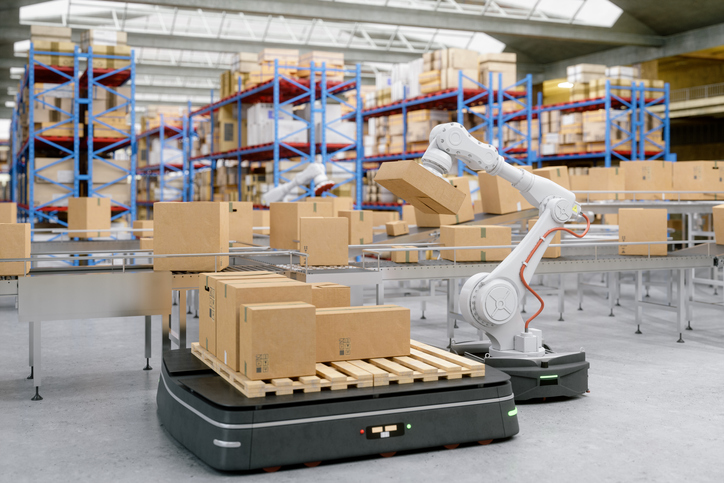From Cell Phones to Robots: 30 Years of Workplace Evolution with Let’s Talk Science
This year marks the 30th anniversary of Let’s Talk Science and much has changed over three decades. Cell phones have shrunk from the size of a brick to something that fits in our pockets. The first text messages became possible, and the first cell phone camera was invented almost 30 years ago. Around that time, climate change first became front-page news and we saw advances in space exploration, healthcare, human rights, as well as huge geopolitical shifts.
This period has also seen tremendous changes in both the nature of work and in the workplace itself. As in the preceding decades, many workplace changes have occurred because of advancements in technology. New machines, new inventions, and new tools have had a direct impact on the workplace. There have also been many social and cultural changes resulting in today’s workplaces being much more diverse than they were 30 years ago. This diversity also include the age range of workers present in the workforce - today many workers are opting to continue working beyond what was once seen as retirement age and, as a result, many workplaces have workers representing all age groups.
For many workers today, salary is not the main criterion for employment and people are looking at a variety of factors when choosing where they work and what they do. While this has always been the case, this trend has increased in the past 30 years. More than ever before, personal values come into deciding which business to work for. Many want to work in a place that does good for society and that is concerned about their wellness and wellbeing. Recognizing that a healthy, happy workforce is a productive one, over the past 30 years, many businesses have developed programs to attract and support their workers.

This period has also seen efforts to address equity, diversity, inclusion, and accessibility (EDIA) across our society. Programs to encourage more women, black, Indigenous, and people of colour into areas where they have historically been underrepresented has had a positive impact on developing a more diverse and representative workforce. The perspectives, knowledge, and skills of underrepresented groups have enriched the workplace, and their presence has also helped change workplace culture. While there is still work to do, policies and training programs have helped build the understanding that what was once seen as “politically correct” behaviour is just treating others, regardless of their race, gender, sexual orientation, etc., with common decency.
For the most part, the changes that have occurred because of cultural and societal changes have been evolutionary in nature. However, the period during which Let’s Talk Science has been active has also seen workplace changes that can only be described as revolutionary. These revolutionary changes are the result of what has been termed the digital revolution.
It was the emergence of personal computers in the 1980’s and the subsequent proliferation of networked computers, the internet, and mobile devices in the 1990’s that laid the groundwork for the digital revolution which has transformed the world of work and continues today. While the impact of the digital revolution is most obvious in office-related workplaces, no sector has been immune to the effects of digital technology. From the use of geographic positioning systems (GPS) and drones in agriculture and natural resources, to cloud-based inventory management and procurement systems in manufacturing, to the use of video technology in medicine and skilled trades, digital technology is essential in today’s workplace.
At the start of the 1990’s, many jobs still required a physical presence at a specific location. Today, the digital revolution has made remote work both feasible and desirable. Video conferencing and project management tools allow many employees to work from anywhere with an internet connection. For these workers, the traditional concept of the workplace no longer applies.
At Let’s Talk Science we have witnessed this firsthand. Our first office and staff were in London, Ontario. Today, while we still have a physical office in London, more than half of our staff work remotely. In addition to supporting the needs of local staff for whom working remotely helps them establish a better work-life balance, these tools have enabled us to attract and retain talented individuals from across the country, most of whom would not have been able to relocate to London.


Since the early 1990’s both artificial intelligence (AI) and robotics have expanded their capacity for use in the workplace. Early robots were fixed machines which performed simple, repetitive functions such as spot welding on a manufacturing line. Over the years the functionality of robotic devices has improved, and they have become a larger part of many workplaces. In fact, a 2018 Financial Post article stated that Canada had 136 robots per 10,000 employees and this number is growing. In some cases, they have replaced human workers; in other situations, they have augmented what humans can do. Robots are used in mining and agriculture as well as on construction sites. Robot cleaners scrub and shine floors in public spaces such as shopping malls; food-delivery robots are replacing other unskilled positions. Some of the new robots are collaborative robots which work with humans to fulfill a specific task.
In general, the tasks which have gone to robots are those which are repetitive or dangerous. Tasks that require fine motor precision, critical thinking, problem solving, and social skills still can only be performed by humans. And the use of robots doesn’t necessarily mean a workforce reduction. A 2020 Statistics Canada report indicated that companies that invested in robotics actually hired 15% more workers than those that did not. Someone has to program, maintain, and repair these robot workers and in some cases, robots lead to increased productivity and expansion, which in turn creates more jobs for human workers.
Even Let’s Talk Science hasn’t been immune to the influence of AI or robotics. While you won’t see any robot workers at Let’s Talk Science (yet), you will see that we are creating programs and resources that will help students thrive when they enter the future workplace. These programs include such things as learning about AI, computational thinking, and computer programming, to those that help develop skills and abilities that can’t be replicated by robots. This future-looking approach aligns with the needs expressed by industry and the goals of educational leaders across Canada.
Together the social, cultural, and technological changes of the last 30 years have had a huge impact on both workers and their workplaces. We’ve seen the rise of the gig economy. We’ve seen a rise in careers related to climate change and sustainability. We have seen a rise in the use of AI and robotics as both job replacers and job creators. The last 30 years have shown that skills gained through involvement in programs related to STEM (Science, Technology, Engineering, and Math) have become more valuable in all sectors of the workplace. So, what do the next 30 years hold? To quote baseball legend, Yogi Berra, “It’s tough to make predictions, especially about the future.” However, one thing we can be sure of is that change will occur. Regardless of our workplace, or the work we do, lifelong learning, always seen as a useful attitude for individuals to have, will become the norm for all workers.
References
Courtney, K. (2022). How the workplace has changed in the past 20 years. Accessed October 26, 2023, at https://www.irishtimes.com/special-reports/great-place-to-work/how-the-workplace-has-changed-in-the-past-20-years-1.4816412
Cummings, M. (2021). More robots are entering Canadian workplaces — but they're not all coming for our jobs. Accessed October 26, 2023, at https://www.cbc.ca/radio/costofliving/robots-might-take-your-job-but-they-could-also-generate-new-ones-that-is-unless-you-re-a-middle-manager-1.5998664/more-robots-are-entering-canadian-workplaces-but-they-re-not-all-coming-for-our-jobs-1.5998864
Davenport, T. H. and Kirby, J. (2015). Beyond Automation. Accessed October 26, 2023, at https://hbr.org/2015/06/beyond-automation
Deering, S. (2023). How has the workplace changed over time? Accessed October 26, 2023, at https://theundercoverrecruiter.com/workplace-evolution/
Delheimer, S. (2023). Using drones in agriculture and natural resources. Accessed October 26, 2023, at https://www.nifa.usda.gov/about-nifa/impacts/using-drones-agriculture-natural-resources
Fabiano, J. (2019). 10 ways the workplace has changed since 2020. Accessed October 26, 2023, at https://www.theladders.com/career-advice/workplace-changes-since-2010
Johanns, K. (2022). How the world of work has changed in the 21st century. Accessed October 26, 2023, at https://jobs.washingtonpost.com/article/how-the-world-of-work-has-changed-in-the-21st-century/
Marshall, J. A. (2021). How robotics are changing jobs in Canada. Accessed October 26, 2023, at https://globalnews.ca/news/7661927/jobs-canada-robitics-artificial-intelligence/
Statistics Canada (2020). Study: The Employment Consequences of Robots: Firm-level Evidence. Accessed October 26, 2023, at https://www150.statcan.gc.ca/n1/daily-quotidien/201102/dq201102d-eng.htm.
Vargas, S. (2018). Robots in the workplace. Accessed October 26, 2023, at https://www.safetyandhealthmagazine.com/articles/16789-robots-in-the-workplace